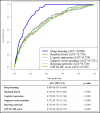Artificial intelligence algorithm for predicting mortality of patients with acute heart failure
- PMID: 31283783
- PMCID: PMC6613702
- DOI: 10.1371/journal.pone.0219302
Artificial intelligence algorithm for predicting mortality of patients with acute heart failure
Abstract
Aims: This study aimed to develop and validate deep-learning-based artificial intelligence algorithm for predicting mortality of AHF (DAHF).
Methods and results: 12,654 dataset from 2165 patients with AHF in two hospitals were used as train data for DAHF development, and 4759 dataset from 4759 patients with AHF in 10 hospitals enrolled to the Korean AHF registry were used as performance test data. The endpoints were in-hospital, 12-month, and 36-month mortality. We compared the DAHF performance with the Get with the Guidelines-Heart Failure (GWTG-HF) score, Meta-Analysis Global Group in Chronic Heart Failure (MAGGIC) score, and other machine-learning models by using the test data. Area under the receiver operating characteristic curve of the DAHF were 0.880 (95% confidence interval, 0.876-0.884) for predicting in-hospital mortality; these results significantly outperformed those of the GWTG-HF (0.728 [0.720-0.737]) and other machine-learning models. For predicting 12- and 36-month endpoints, DAHF (0.782 and 0.813) significantly outperformed MAGGIC score (0.718 and 0.729). During the 36-month follow-up, the high-risk group, defined by the DAHF, had a significantly higher mortality rate than the low-risk group(p<0.001).
Conclusion: DAHF predicted the in-hospital and long-term mortality of patients with AHF more accurately than the existing risk scores and other machine-learning models.
Conflict of interest statement
The authors have declared that no competing interests exist.
Figures





References
-
- Ponikowski P, Anker SD, AlHabib KF, Cowie MR, Force TL, Hu S, et al. Heart failure: preventing disease and death worldwide. ESC Hear Fail. 2014;1: 4–25. - PubMed
-
- Ambrosy AP, Fonarow GC, Butler J, Chioncel O, Greene SJ, Vaduganathan M, et al. The global health and economic burden of hospitalizations for heart failure: Lessons learned from hospitalized heart failure registries. J Am Coll Cardiol. Elsevier Inc; 2014;63: 1123–1133. 10.1016/j.jacc.2013.11.053 - DOI - PubMed
Publication types
MeSH terms
LinkOut - more resources
Full Text Sources
Medical
Research Materials
Miscellaneous

